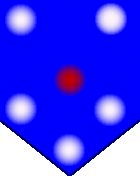
This is a new alien critter, introduced in the new Heritage series from Avon Eos. We get only an uninformative glimpse of this fellow in Book 2, Luna Marine, where he is described as "Species 84," a representative of one of many alien civilizations recorded in a visual library or communications facility built by advanced alien colonizers beneath the Martian surface half a million years ago.
Though we don't see much of him directly, we do learn that his species, the An, were spacefarers several thousand years ago, that they left wreckage and ruins on our Moon, and that they colonized parts of our Earth between six and twelve thousand years ago, building numerous cities and enslaving -- and civilizing -- the local human populations. Eventually, they were all but exterminated by another culture known only as "the Hunters of the Dawn." The struggle destroyed the An's colony centers on Earth and on the Moon, flooded vast stretches of Mesopotamia and the Nile Delta, and left scattered bands of former slaves to begin the laborious process of building a new civilization on their own.
In creating the An, I borrowed heavily from Sumerian myth, and from the fact that both the Sumerian and Egyptian cultures appeared relatively suddenly, with a degree of sophistication, from obscure backgrounds: both credited civilization to the gods who formerly walked among humans as their creators and masters; and both have mythologies that read more like science fiction than religion.
In Luna Marine, I did considerable research into both Sumerian myth and language, using, wherever possible, actual Sumerian words and phrases. In the Sumerian mythos, both heaven and the supreme creator-deity were called "An" or, in later versions, "Anu." Their name for Earth was Ki, a word that made its way to Greece as "gi" or "geos" and on to modern English through such words as "geometry" and "geology." The Moon was called Kingu, which means something like "Defender of the Earth."
A number of gods who came to Earth from An were known as the "Annunaki," roughly translated as "Those of Heaven Who Came to Earth." The Annunaki were credited with everything from the creation of Man to the invention of agriculture, domesticated animals, religion, money, language, and writing.
In the Heritage series, the An are described as pseudoreptilian, homeothermic, and vivaparous. Despite the fact that I dislike having to rely on humanoid aliens, the An are indeed humanoid . . . mostly because the representations of the Annunaki in Sumerian art, of Oannes in the remarkable Sumerian story of an amphibious civilizer from Sirius related by Berossus, and of the "Neteru" or "Watchers" in Egyptian mythology, are all of human or human-like figures. The An have six digits on each hand, which is why we, today, still have base twelve and base sixty numerical systems in our time keeping, calendars, and zodiac -- all passed down to us from the Sumerians by way of ancient Babylon. They have an architectural predilection for flat-topped pyramids, which explains the interest in those structures both in Egypt (I've assumed that the tops of the Great Pyramids were added on later, in Pharaonic times) and in the ziggurats of Sumeria, as well as, possibly, the pyramids in Mesoamerica.
Their ancient starfaring culture was completely destroyed by the Hunters of the Dawn, but isolated colonies did survive, albeit as stone-age primitives. The nearest we know of so far is on the Earthlike satellite of a gas giant in the Lalande 21185 star system, only nine light years from Earth. If all goes as planned, the first book of the second Heritage trilogy will at least partly follow Earth's first expedition to that system, complete with a complement of U.S. Marines embarked on board the starship.
Twins separated at birth?On the left, a photo of a mask of unknown origin downloaded off the Internet. On the right, an illo of an An, created before I saw the mask photo.
The guy who posted the photo thought it reminded him of an ancient Sumerian fish-god. Shades of the amphibious Oannes (An-ess?) of Berossus!




























































No comments:
Post a Comment